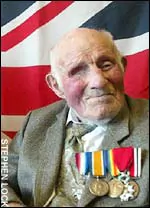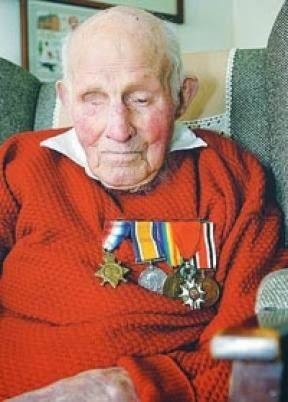Name Albert Marshall | Role Veteran | |
 | ||
Died May 16, 2005, Ashtead, United Kingdom | ||
Pezzakustjoni ma albert marshall
Albert Elliot "Smiler" Marshall (15 March 1897 – 16 May 2005) was a British veteran of the First World War and the last surviving British cavalryman to have seen battle on the Western Front.

Albert Elliott Marshall was born on 15 March 1897 in Elmstead Market, a village in the Tendring district of Essex, close to Clacton-On-Sea, Great Bentley, Wivenhoe and Colchester.
Albert was the eldest of three children born to James William Marshall and Ellen Marshall, née Skeet. Albert’s mother, Ellen died in 1901 at the age of twenty-four, leaving James to raise their children on his own. They remained in Elmstead Market with them appearing on the 1911 census, showing Albert, by this time age fourteen as a farm labourer. James was a strict father; however Albert always stood his ground, both as a boy and as a man. When he was set upon by lads from a neighbouring village, Smiler was roundly beaten up. Cut and bruised he returned home to meet his father who burst out laughing, "Ah, at last you have met your Waterloo’ he cried, thereby acknowledging that his son could also hand out a little of the rough stuff when he wanted to.
Marshall served in the 1/1st Essex Yeomanry and later the 8th Battalion, Machine Gun Corps between 1915 and 1919 and saw action at the Battle of the Somme, Battle of Arras, the Third Battle of Ypres, the Germany Offensive of 1918 as well as the Advance to Victory and the Army of Occupation campaigns at the end of the war. Marshall recalled the horrors of the battlefield and his memories of seeing many of his comrades blown to bits by enemy shells or mown down in No Man’s Land by a haze of bullets.
Marshall joined the Essex Yeomanry in 1915, at the age of seventeen, after lying about his age; he took part in the first major Battle of Loos in the same year. Marshall was given the nickname, ‘Smiler’ after he threw a snowball at a drill sergeant who threatened to ‘give him something to smile about’. This event occurred during his basic training at Stanway. Smiler recalled to Richard van Emden that whilst doing physical jerks,
"Sergeant Beavis of Clacton-On-Sea said ‘Trunk forward, bend!’ I bent down, and I was a bit of a lad – threw a snowball at the row in front and it hit a chap up the behind. He jumped up, and so did two or three of the others …"
The Battle of the Somme, beginning on 1 July 1916 had no greater resonance for Smiler than all the other battles he had fought throughout the war. He had been sent to France in late 1915 and despite a number of periods of home leave had remained in or near the front line for the remainder of the war. He was present on the Somme for the first day of the offensive in which over twenty-thousand troops were killed in the first several hours, with forty-thousand more injured, making the battle one of the heaviest death and wounded tolls in the whole war. Marshall had been kept well behind the lines during the opening day of the Somme campaign waiting for a breakthrough, however it did not come.
As a result of his unit being kept back during the Somme, Marshall was not credited with being the last veteran of that fateful day; however he was there and remembered the trauma and horror of that campaign and the images on the battlefield would remain with him until the day he died. Marshall later recalled to historian Richard Van Emden picking up and sending home the letters found next to the body of a man killed near Mametz Wood, an act of generosity and kindness that belied his tough exterior.
In March 1917, Smiler suffered a 'blighty wound' in the hand and was sent home. On his return he joined the Machine Gun Corps and fought at the Battle of Cambrai where he was captured as a Prisoner of War by the Germans. Smiler was released by his captors as they were short of rations and returned to the front.
When the First World War ended in 1918, Smiler Marshall volunteered for a tour of duty in Ireland and was stationed near Dublin. He was demobbed in 1921 and returned home to Tendring where he married Florence C Day. The couple had five children, only one of whom was still living at the time of Albert’s death in 2005.
In his later years he continued to reside in a small house, which was attached to a larger house in which he had worked for the owner since the Second World War. As old age began to take its toll on Smiler, efforts were made to allow him to remain as independent as possible, his bed, which had always been upstairs was moved down, for his convenience, as was his bedside table on which stood one of his numerous souvenirs of the First World War, a wooden cross taken from the rubble of Albert Basilica on the Somme. It was stuffed into the rear of a wagon and retrieved later; Smiler brought it home and kept it by his bedside for the rest of his life.
In the final decade of his life, Smiler was awarded the Legion d’honneur and appeared on numerous television shows as well as attending the veterans’ party at Buckingham Palace. Furthermore, he took part in three pilgrimages to the battlefields of the First World War, including one to mark the eightieth anniversary of the Third Battle of Ypres, a battle in which he had been involved in.
Albert Elliott ‘Smiler’ Marshall died at the age of 108 on 16 May 2005 in Ashtead, Surrey. At the time of his death he was survived by one son; twelve grandchildren; twenty-four great-grandchildren and four great-great-grandchildren.
Marshall’s legacy as a final veteran of the First World War was that he was able to claim a number of records: the last man to wear the 1914-15 Star; the last man to serve on the Somme and perhaps, the most significant for a man who had served in the Essex Yeomanry, the last man to have served in the cavalry.
